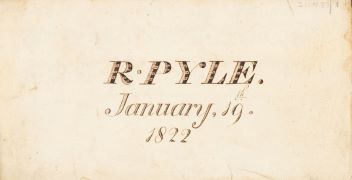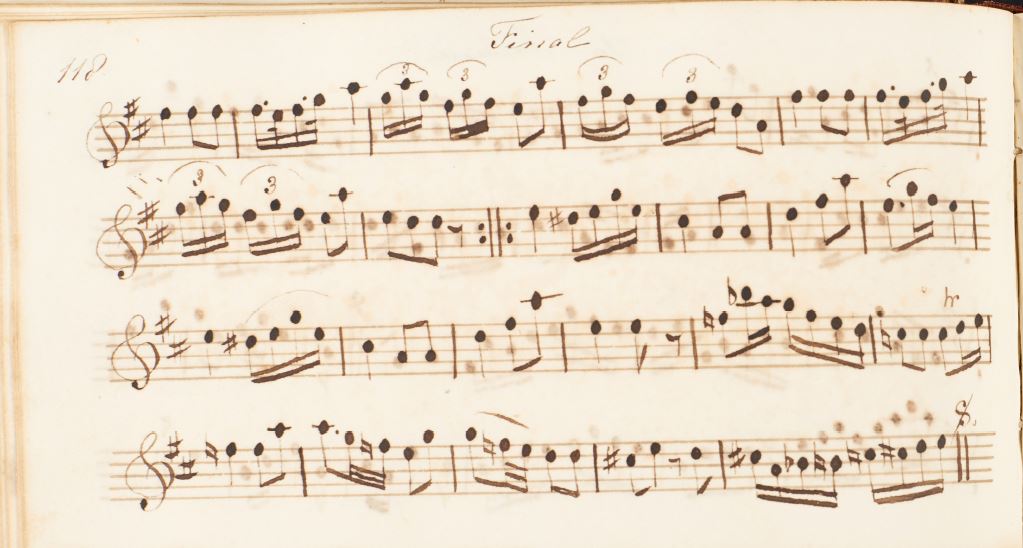Music from English local archives in RISM
Stephen Rose
Thursday, September 26, 2024

The following guest post is by Stephen Rose (Head of Music Department, Royal Holloway, University of London, UK):
Until recently, RISM’s records for the United Kingdom have focused on the holdings of major research libraries such as the British Library, Cambridge University Library and Oxford’s Bodleian Library. Now a richer and more decentralised record of musical sources in England is emerging on RISM through the project Music, Heritage, Place: Unlocking the Musical Collections of England’s County Record Offices. This two-year project is led by Stephen Rose at Royal Holloway, University of London, in collaboration with 10 partner organisations including Newcastle University, and is funded by the UK’s Arts and Humanities Research Council. The project is creating RISM catalogue records for musical sources between c.1550 and c.1850 in England’s local archives. We are digitising selected sources, including vernacular music manuscripts from Hampshire thanks to the support of the Hampshire Archives Trust. The project is uncovering previously untold stories of musical life in local villages and towns, and is organising concerts, public talks and schools workshops to reconnect this musical heritage with the communities where it originated.
England’s counties have been administrative areas for local government since Anglo-Saxon times. Today there are about 50 county record offices, holding the archives of local government, towns and churches, as well as papers gifted or deposited by private families. Our project is focusing on about 40 record offices with significant holdings of notated music. This work has required the creation of 18 new RISM sigla, from GB-RRkk at England’s south-west tip to GB-CLas near the northern border with Scotland. Several other sigla have been revised to reflect the changed location or name of an archive. Our project has already added over 2500 new records to RISM, and many more will follow during the project’s duration until 2026.
The project is creating a more decentralised picture of England’s holdings of early printed music, uncovering exemplars beyond those held at major research libraries. The RISM entry for John Cosyn’s Musike of six and five parts (1585) previously listed UK copies at the British Library, Bodleian Library and Winchester Cathedral; we have now added holding information for a fragmentary exemplar in Kresen Kernow, Redruth, Cornwall (RISM Catalog | RISM Online). Such discoveries enrich our understanding of how printed music was acquired and used beyond the main centres of England.
Many of the music manuscripts in local archives stem from the collections of parish churches. These institutions often had bands of singers and instrumentalists in the late 18th to early 19th centuries, playing a repertory of ‘West Gallery’ music. Examples from around 1800 include the manuscripts of anthems and psalms from Bramley in Hampshire (RISM Catalog | RISM Online), along with partbooks of Christmas hymns from Nether Wallop (RISM Catalog | RISM Online). Local archives also hold significant collections from private families, ranging from the collection of the Harpur Crewe family of Calke Abbey (now held at Derbyshire Record Office), to the music manuscripts of women from the Broadwood family of piano manufacturers (now held in Surrey History Centre).

William Knapp, “Hear, O Heavens” copied c.1824 in Joseph Farmer’s psalmody book, Bramley Parish Church. Hampshire Record Office, 63M70 PZ39 (RISM Catalog | RISM Online). Catalogued and digitised with the support of Hampshire Archives Trust
Some of the most intriguing sources in local archives are deeply personal documents: musical notebooks or tune books associated with a specific individual, often rich in inscriptions and annotations. Tune books show how an individual collected and adapted the music around them. The tune book of Richard Pyle (c.1808–80), a gentleman farmer in Nether Wallop in Hampshire, includes country dances, psalm tunes, instrumental duos, an anthem, and arrangements of tunes from London theatres and from Rossini’s opera Tancredi (RISM Catalog | RISM Online). Copied from 1822 onwards, Pyle’s book shows the music available to a farmer in a small village about 130 km (80 miles) from London.

Giaochino Rossini, “Di tanti palpiti” from Tancredi, copied in Richard Pyle’s tune book c.1822. Hampshire Record Office, Mouland of Nether Wallop papers, 210M87/1 (RISM Catalog | RISM Online). Catalogued and digitised with the support of Hampshire Archives Trust
Little known or newly discovered material recently catalogued in the project will be discussed in the next news item, including Haydn manuscripts in Derbyshire and manuscript copies of church music by Henry Purcell. Our project demonstrates the immense value of the RISM catalogue not only to international researchers but also to local historians and musicians seeking to understand their musical heritage.
Image above: Richard Pyle’s tune book, 1822, title page. Hampshire Record Office, Mouland of Nether Wallop papers, 210M87/1 (RISM Catalog | RISM Online). Catalogued and digitised with the support of Hampshire Archives Trust
Share Tweet EmailCategory: Library collections

